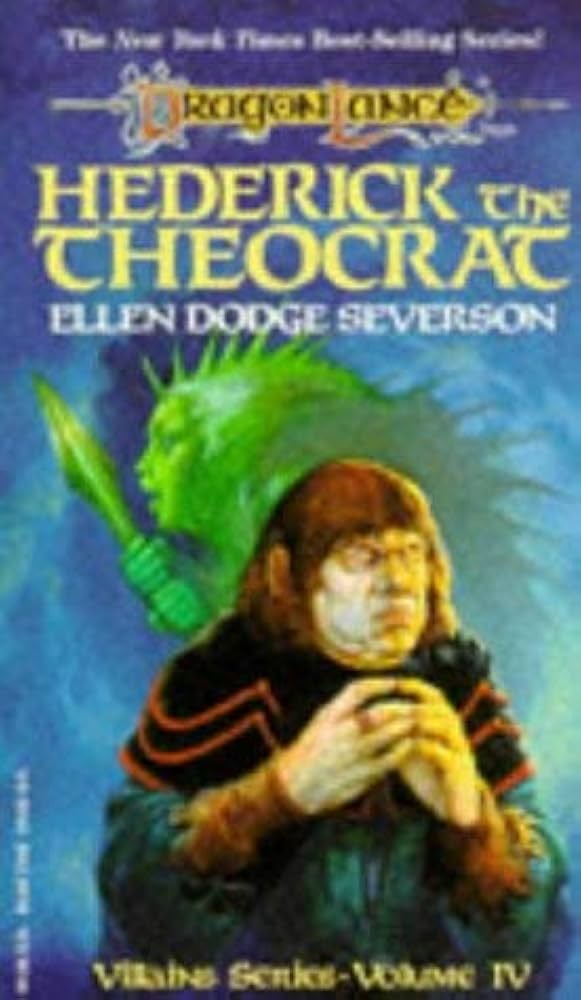Hederick the Theocrat

Table of Contents
ToggleOverview
Hederick the Theocrat, written by Ellen Dodge Severson, is part of the Villains series in the Dragonlance universe. The novel traces the origin and rise of one of Krynn’s most reviled figures—the mad zealot of Solace who wielded the staff of the Theocrat and terrorized his community in the name of divine order.
More than a simple villain origin, this is a psychological portrait of fanaticism, insecurity, and the perversion of faith. It examines how fear of chaos can turn a man into a tyrant cloaked in religious authority.
Main Character: Hederick
Once a frail and overlooked man, Hederick is driven by an overwhelming need for control and validation.
He hides deep insecurities beneath a veneer of spiritual superiority.
His arc is one of descent—each choice moving him further from compassion and closer to authoritarian extremism.
His rise to the title of High Theocrat is not a triumph, but a tragedy of ego, fear, and self-deception.
Supporting Characters
Kelric – A childhood rival who challenges Hederick’s authority and exposes his vulnerability.
Jemra – A kind-hearted healer who attempts to temper Hederick’s zeal with empathy, serving as the moral conscience of the story.
The High Priests – Figures who guide or manipulate Hederick depending on their own motives and ambitions.
The People of Solace – Their suffering, silence, or resistance shape Hederick’s increasing paranoia and cruelty.
Setting
The novel is set in and around the town of Solace, particularly during the chaotic years following the Cataclysm.
As order collapses and faith is shaken, Solace becomes the perfect incubator for Hederick’s rise. The famous Vallenwood trees and peaceful atmosphere turn into a place of dread under his rule.
The temple, once a place of refuge, becomes a throne of judgment and fear.
Plot Summary
The story begins with Hederick as a frail, bitter man living in the shadow of stronger, more charismatic peers. His obsession with control and righteousness grows as the world around him begins to fracture in the wake of the Cataclysm.
Discovering religious texts and driven by visions (real or imagined), Hederick dedicates himself to purging sin and disorder from Solace. He becomes a charismatic preacher, eventually enforcing his doctrine with the infamous staff that delivers divine punishment.
But his crusade spirals into tyranny. Doubters are punished, mercy is outlawed, and those closest to him either flee or perish. As his power grows, so too does his delusion.
The novel culminates in the full transformation of Hederick into the High Theocrat—feared, loathed, and utterly convinced of his divine mandate.
Themes
Fanaticism and Fear – The novel explores how fear of disorder can evolve into dangerous extremism.
The Corruption of Faith – Hederick’s spiritual journey becomes a cautionary tale of using belief to justify cruelty.
Power and Paranoia – As Hederick gains power, he becomes increasingly isolated and tyrannical.
Redemption Denied – Opportunities to change are offered but refused, making his fall all the more tragic.
Tone & Style
Hederick the Theocrat is intense, somber, and psychological. It blends character study with gothic undertones and societal commentary.
The prose is introspective, occasionally surreal, and sharply focused on internal conflict and ethical decline.
Reception
Praised for:
A chilling and convincing portrait of religious tyranny.
Adding depth to a character who was previously seen only as an antagonist.
Emotional and moral complexity.
Some critiques:
Grim tone throughout with little levity.
Not for readers seeking heroics or traditional fantasy adventure.
Final Thoughts
Hederick the Theocrat is a disturbing, compelling deep dive into how fear, ego, and faith can twist a man—and a town—into something unrecognizable. It’s a vital read for understanding one of Dragonlance’s most insidious villains.
A tragedy not of monsters, but of men who convince themselves they are right no matter the cost.
Recommended for:
Fans of dark character studies and villain origins.
Readers interested in religious and political commentary in fantasy.
Dragonlance followers curious about the early days of Solace and its transformation under tyranny.
